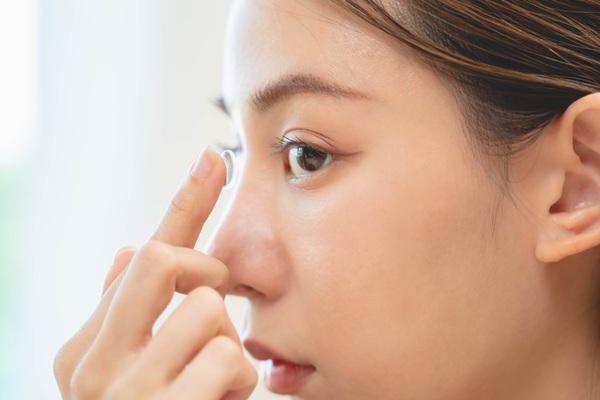Are Progressive Lenses Right for you?

Thinking progressive lenses may be in your near future? Many people need to wear prescription eyeglasses so they can see clearly. That is important so they can perform their everyday functions without issue. The fact that there are many different types of prescription eyeglass lenses means that you have choices.
No matter what your age is or what your visual needs are, know that it is worth your time to look further into how progressive lenses can help improve your overall quality of life.
What are progressive lenses?
Learning more about what progressive lenses can do for you is a great idea. While the need to wear progressive lenses tends to increase with age, anyone can benefit from wearing this corrective lens option. Progressive lenses are a type of lens that allows wearers to see up close and far away. Instead of needing to wear single-vision eyeglasses to see far away and reading glasses to see up close, all you need to do is wear progressive lenses to clearly see both distances.
How do progressive lenses work?
Progressive eyeglasses work by providing wearers with a gradual transition from the bottom of the eyeglasses to the top of the eyeglasses. The bottom part of the eyeglasses will be made using the prescription the patient needs to see things up close. The top part of the eyeglasses will be made using the prescription the patient needs to see things far away. The part of the eyeglasses in which the two prescriptions meet allows wearers to see things in between these two distances clearly.
How are progressive lenses different from single-vision prescription glasses?
Single-vision eyeglasses are made using lenses that offer the same level of seeing power from edge to edge. They are the most common type of prescription lens made for eyeglass wearers and are often prescribed for those who have been diagnosed with nearsightedness, farsightedness, or astigmatism. Single-vision eyeglasses require wearers to switch eyeglasses when changing their views.
Progressive lenses allow for two and even three different levels of seeing power, such as bifocals or trifocals. Using the same lens, wearers can see clearly up close, far away, and mid-range. There is no line to differentiate the different levels, allowing for a uniform and clean look. There is no need to switch eyeglasses when wearing progressive lenses as they allow wearers to see everything clearly, no matter how close or how far they are from what they are looking at.
How can progressive lenses improve one’s quality of life?
It may take some time to adjust to using progressive lenses, and some people just cannot use them. On the other hand, there are a few valid justifications for donning them. The following is a list of ways that progressive lenses can improve one’s quality of life:
Those who wear more than one pair of eyeglasses need to wear only one pair of eyeglasses to see things both up close and far away. This is much more convenient and therefore helps to simplify one’s life
Progressive lenses are clear, which means there are no multifocal or bifocal lines present. This allows for a more modern and youthful appearance, which is a feature that most eyeglass wearers are looking for nowadays
They offer a larger range of vision when compared to standard prescription eyeglasses. This means seeing more of what is in one’s range of vision as well as seeing it all more clearly. Individuals might benefit from using progressive lenses if they want a more unobtrusive, modern, and young appearance while using multifocal lenses.
People of all ages may benefit from the fashionable design of progressive lenses, which are essential if you have a refractive problem. The benefits of wearing progressive lenses, which let wearers see well at varying distances, considerably outweigh the negatives, the most significant of which is the adjustment period. For those who do not mind dealing with the initial discomfort of trying out new glasses and want a more unobtrusive appearance than they get with bifocals or trifocals, progressive lenses are a great option.
Ready to make a decision?
Are progressive lenses a good choice for you? If you are looking for a convenient solution that requires you to only wear one pair of eyeglasses to see both up close and far away, then progressive lenses will make your life easier. Imagine only needing to put on one pair of eyeglasses to address all of your vision needs. How much easier will it be for you to perform your everyday functions? When you choose progressive lenses, all of your vision needs are addressed by one single pair of eyeglasses.
Request an appointment here: https://www.texasoptical.net or call Texas Optical at (214) 771-7333 for an appointment in our Dallas office.
Check out what others are saying about our services on Yelp: Read our Yelp reviews.
Recent Posts
For those living with diabetes, undergoing a diabetic eye exam is one of the most important steps in protecting their vision and overall eye health. High blood sugar levels can lead to a range of complications, including conditions that damage the eyes over time. These exams help detect these issues before they become serious, allowing…
Contact lenses provide clear vision and convenience for individuals who prefer an alternative to eyeglasses. However, proper care and maintenance are essential to prevent infections, irritation, and eye damage. Neglecting hygiene practices can lead to serious eye conditions, including corneal ulcers and keratitis. Understanding how to clean, store, and handle contact lenses ensures long-term eye…
Maintaining eye health and preventing long-term issues is the result of consistent and quality vision care. Many people focus on overall wellness but may overlook daily habits that support healthy eyesight. However, taking simple steps each day can protect vision, reduce eye strain, and prevent future complications. By making eye health a priority, it is…
Prescription contacts provide vision correction, comfort, and convenience for those who do not want to wear glasses. However, caring for and wearing contacts takes some getting used to. Learning to insert, remove, and maintain them will help ensure a comfortable and safe experience.Not all contact lenses are the same, and choosing the right pair is…


